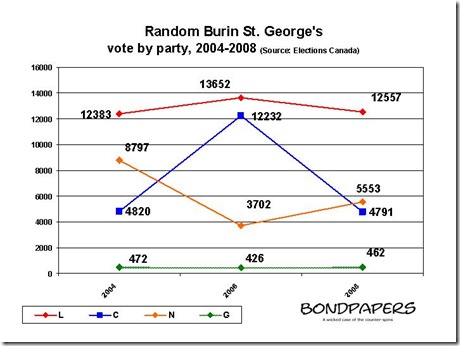CBC Radio is running a short series of reports on remittance workers. Those are people who maintain a permanent residence in Newfoundland and Labrador but who travel to other places, mostly Alberta, to earn a living.
If the CBC figures are accurate - upwards of 10,000 people earning pre-tax salaries of $100,000 a year - then remittance labourers are contributing to the Newfoundland and Labrador economy on a scale that rivals agriculture and the fishery.
Remittance labour is a common feature of the economy in the developing world. The figures for Newfoundland and Labrador would be also on a par with some countries at the low end of the scale in a 2003 World Bank study. Bond Papers noted the local history of remittance work in a post earlier in 2007.
The local workers involved in the Newfoundland and Labrador version of remittance labour include fishery workers displaced by changes in that industry. Others are older, skilled workers from the former paper plant at Stephenville or from the shipyard at Marystown. Neither of these groups will likely be doing the Big Commute for a long time. Either the projects they are working on will shut down or they will retire in Newfoundland and Labrador.
Others are young men and women who are attracted by high wages and steady work in their chosen fields. While the older workers are contributing to a localized economic boom in places without major industries - like Marystown or Stephenville -
Only a major and sustained series of local projects rivaling the work elsewhere will cause the younger workers to stay in the local labour force. Many are likely to settle outside of Newfoundland and Labrador.
In that context, it's interesting to recall that in 2003 Danny Williams campaigned on his commitment to "growing" the economy and creating jobs. He didn't do that, of course, as Bond Papers has noted several times, including in a reprint of a 2004 column from the original (pre-Cleary) incarnation of The Independent. The economic miracle of the past four years has been entirely due to the upsurge in world oil prices.
Essentially, the current progressive Conservative administration is following the same approach of its predecessors. The long-term is sacrificed to short-term expediency. The rise of highly-paid remittance work has served to both cushion the blow of outmigration and enable the provincial government to contribute disproportionately to the provincial economy in the process.
The current administration started out, supposedly, with a plan to control spending and deal with the burgeoning provincial debt. In reality, it did nothing about either. Spending has grown by 35% - well beyond the rate of inflation - and at the same time, the provincial direct and total debt is larger today than it was in 2003. Spending is forecast to increase, as is the debt.
Both oil prices and the remittance economy are shaky underpinnings for government spending and development of larger debt. Oil prices are historically subject to significant fluctuations. The remittance economy is limited either by the life of projects or the short time some of the workers have left to retirement.
Remittance work and the related subject of demographic changes in the province have been largely ignored by successive provincial governments in Newfoundland and Labrador and there is virtually no discussion of it in the public at large.
Perhaps the CBC report will change that.
-srbp-

